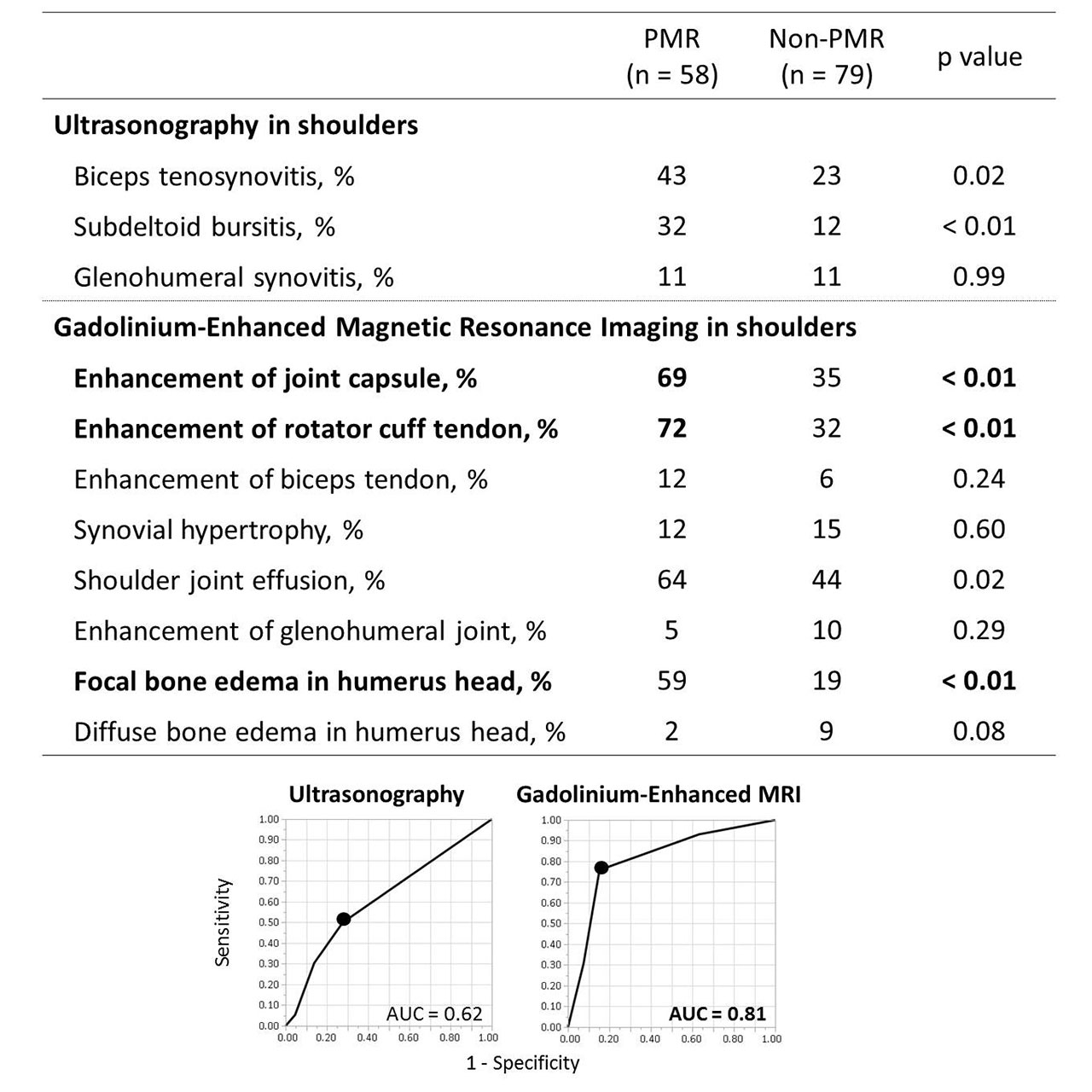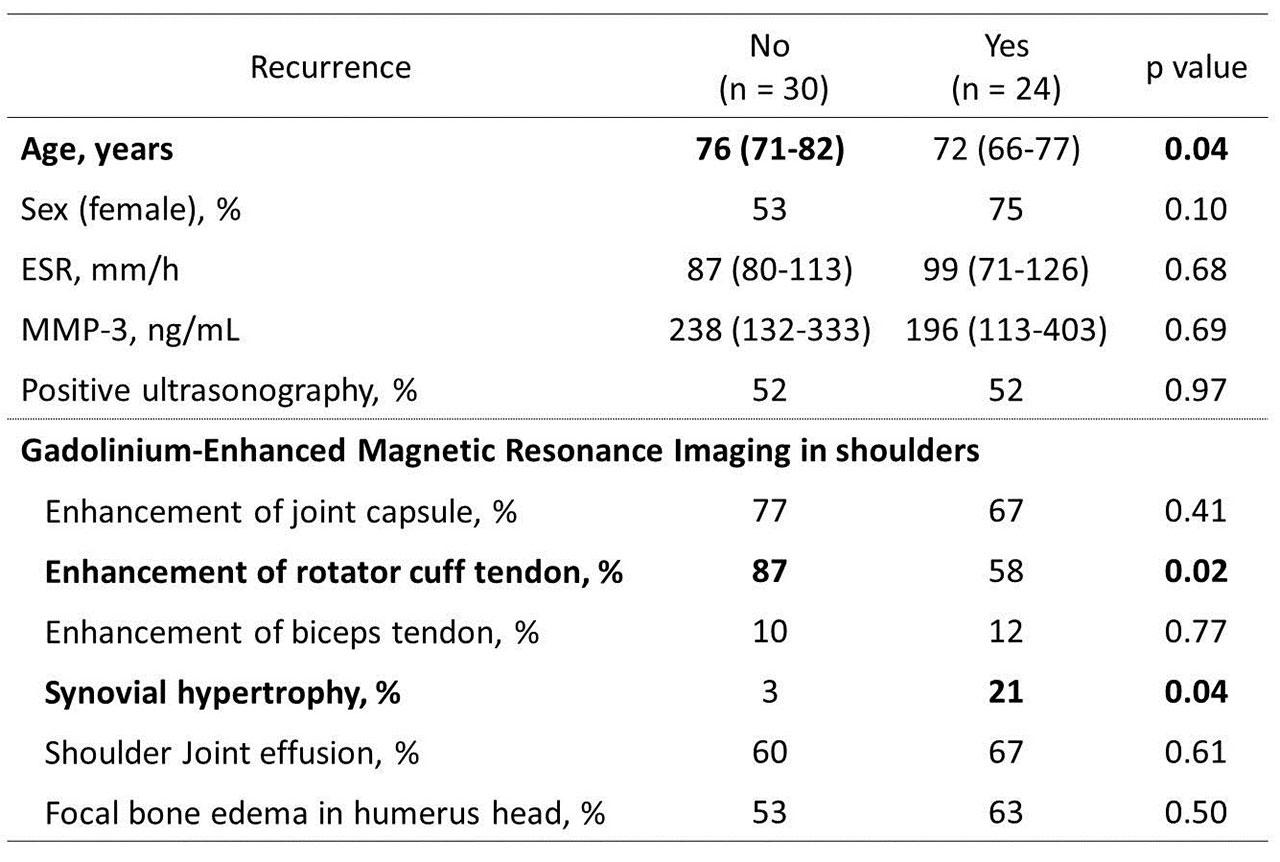Session Information
Session Type: Poster Session (Monday)
Session Time: 9:00AM-11:00AM
Background/Purpose: Polymyalgia rheumatica (PMR) is a glucocorticoid-responsive muscle pain and stiffness, especially in the shoulders and hips. PMR is clinically diagnosed based on the symptoms, although accurate diagnosis is difficult because the symptoms can occur in many other rheumatologic and inflammatory conditions. Recently, it was reported that ultrasonography (US) in shoulders could detect the specific findings to PMR, such as biceps tenosynovitis and subdeltoid bursitis. Magnetic resonance imaging (MRI) also has an advantage of visualizing bone and muscle lesions; however, the application to PMR diagnosis has not been established yet. In this study, we evaluated gadlinium-enhanced MRI findings of the shoulder in patients with PMR. The purpose of this study is to assess whether gadlinium-enhanced MRI could improve diagnostic accuracy and prognosis prediction in patients with PMR.
Methods: This study included the consecutive patients who had bilateral shoulders pain and fulfilled the Bird classification criteria for PMR between June 2012 and June 2018 in Tomakomai City Hospital. Gadlinium-enhanced MRI and US in shoulders were performed in the all patients. We excluded patients declining participation in the study or having contraindications of gadlinium-enhanced MRI. PMR was diagnosed by at least two rheumatologists. MRI and US findings were evaluated by independent radiologists. 20 mg/day of prednisolone was initially administered to patients with PMR, and was tapered after remission. They were followed-up until June 2019 about recurrences.
Results: 269 patients visited our hospital complaining of bilateral shoulders pain, and 175 of them fulfilled the Bird classification criteria for PMR. 137 patients received gadlinium-enhanced MRI and US examinations, and PMR was diagnosed in 58 patients. Enhancement of joint capsule (Fig. 1A), rotator cuff tendon (B) or biceps tendon (C), synovial hypertrophy (D), shoulder joint effusion (E), enhancement of glenohumeral joint (F) and/or focal (G) or diffuse (H) bone edema in humerus heads were found in the patients. Of these MRI findings, enhancement of joint capsule or rotator cuff tendon and focal bone edema in humerus heads were significantly frequent in the PMR patients. If the three findings on MRI were used in combination to diagnose PMR, the sensitivity and specificity were 76% and 85%, respectively, higher than 50% and 72% of US findings (Fig. 2). In the follow-up study, PMR recurred in 24 patients (44%). Patients with recurrent PMR had younger ages, less enhancement of rotator cuff tendon and more synovial hypertrophy findings on MRI (Fig. 3).
Conclusion: Gadolinium-enhanced MRI displayed capsulitis, rotator cuff tendonitis and focal osteitis in shoulders, relatively specific to patients with PMR. Besides, rotator cuff tendonitis and synovial hypertrophy on MRI were associated with recurrences of PMR. Our study suggested that gadolinium-enhanced MRI in shoulders could contribute accurate diagnosis and predicting recurrence to patients with PMR.
To cite this abstract in AMA style:
Kamada K, Nakamura H, Tarumi M, Tanimura S, Horita T. Gadolinium-Enhanced Magnetic Resonance Imaging in Shoulders Contributes Accurate Diagnosis and Predicting Recurrence to Patients with Polymyalgia Rheumatica [abstract]. Arthritis Rheumatol. 2019; 71 (suppl 10). https://acrabstracts.org/abstract/gadolinium-enhanced-magnetic-resonance-imaging-in-shoulders-contributes-accurate-diagnosis-and-predicting-recurrence-to-patients-with-polymyalgia-rheumatica/. Accessed .« Back to 2019 ACR/ARP Annual Meeting
ACR Meeting Abstracts - https://acrabstracts.org/abstract/gadolinium-enhanced-magnetic-resonance-imaging-in-shoulders-contributes-accurate-diagnosis-and-predicting-recurrence-to-patients-with-polymyalgia-rheumatica/



